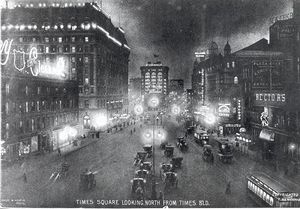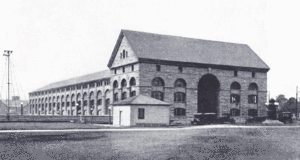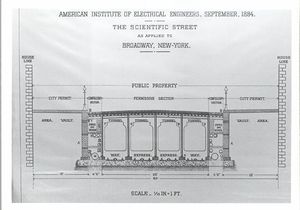Straphanger History: Lewis B. Stillwell's Power to Move People
Lewis B. Stillwell's Power to Move People
This is the third page in a series about the planning and construction of the New York City subway system. The first deals with pre-subway transportation and the second looks at Lewis B. Stillwell’s role in designing the main power station and substations.
After many delays, the New York City Rapid Transit Commission (RTC) officially broke ground for the city’s subway system on 24 March 1900. Construction began two days later.
The challenges were many. Planners knew the subway would have to serve many of the general public’s needs: people would use it to travel to and from work and to get to entertainment venues, among other things. In addition, as RTC announced subway sites, businesses moved to develop and locate near the desirable Interboro Rapid Transit (IRT) stations. In part, Times Square’s success is due to the subway's site; the area’s theatre district began taking shape almost simultaneously with the subway opening Additionally, developers built Macy’s and Saks Fifth Avenue above subway lines purposely to cater to the masses. This development drove up the price of real estate, a factor that caused significant delays in the subway’s groundbreaking and growth.
DC to AC
Beginning in 1892, Thomas Edison-style direct current (DC) generators powered trolleys and elevated trains (Els) in Brooklyn. But by the mid-1890s, the Tesla-Westinghouse alternating current (AC) system proved much more practical for powering homes, industry and transportation, as AC could be transmitted efficiently over long distances — a critical advantage to the subway project.
In November 1898, Westinghouse received a contract for what would be the subway’s main power station and eight substations. The company had installed large-scale AC dynamos at Niagara Falls, and the RTC needed Westinghouse’s electrical expertise.
The Idea is Realized
The original 19 miles of track required a main powerhouse and eight substations. The main generating station produced 3-phase, 25-cycle current at 11,000 volts. The powerhouse, located at 59th Street on the Hudson River, contained nine steam-engine generators with a combined capacity of 100,000 horsepower. River barges delivered coal that fueled the boilers that provided the steam for the generators.
Subway electric power was distributed to each of the eight original substations, which were approximately two miles apart along the subway path. AC ran through high-voltage cables routed through ducts within the subway walls. Once the electricity reached the substation, Westinghouse rotary converters converted it to DC, which powered the rails, track switches, stop arms and signaling equipment.
Twelve thousand men built the subway, using the cut-and-cover method: rather than drilling and tunneling deep beneath the city, they cut a trench to accommodate a typically 55-foot wide and 15-foot high tunnel. They laid the rails and built the stations, enclosing the finished work in steel beams. Finally, they placed a shallow layer of fill and paving over the trench.
The first IRT stations were attractively designed and featured stylish kiosks with mosaic borders for entrances. Many had specially designed plaques linked to the station name or neighborhood. The Astor Place station’s beaver motif, for example, illustrates John Jacob Astor’s involvement in the fur business. The Fulton Street station uses images of Robert Fulton's steamboat. Grand Central Terminal highlights train engine images, while an eagle clutching a shield with the number “33” on it reminded passengers of the regimental armory just above ground.
The Subway Today
Today, the NYC Subway is the city’s largest user of electricity. AC operates signals, station and tunnel lighting, ventilation and miscellaneous line equipment, while DC operates trains and such auxiliary equipment as water pumps and emergency lighting. The system’s 215 electric substations receive high- and low-voltage power from the New York Power Authority, at voltages as high as 27kV AC, prior to transforming it for use within the system. The subway's third rail requires 625 volts DC for operating the trains. Power is distributed throughout the system via 2,500 miles of cable, which passes beneath 7,651 manholes located throughout the city. The power required to operate the subway system during peak hours is about 500 MW. And at 1.8 billion kilowatt hours, the subway’s annual power consumption equals that of the city of Buffalo, New York.


